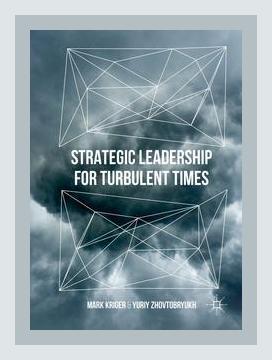Leadership and ManagementStrategic Leadership
Title: Strategic Leadership for Turbulent Times
Authors: Mark Kriger and Yuriy Zhovtobryukh
Year: 2016
Categories: Strategic Leadership
Introduction
“Strategic Leadership for Turbulent Times” by Mark Kriger and Yuriy Zhovtobryukh is a pivotal resource for leaders navigating the complexities of modern organizational landscapes. This summary delves into the core themes, actionable strategies, and illustrative examples provided in the book, emphasizing practical application for leaders in volatile environments.
Chapter 1: Understanding Turbulence in the Modern World
Key Points:
– Defining Turbulence: The authors delineate turbulence as an unpredictable, dynamic environment caused by factors like technological disruption, globalization, and socio-economic shifts.
– Vigilance and Adaptability: Kriger and Zhovtobryukh argue that vigilant and adaptable leadership is essential in such settings.
Example:
– Kodak’s Decline: The book cites Kodak’s failure to adapt to digital photography despite clear early warnings, emphasizing the necessity of staying sensitive to technological advancements.
Actionable Strategy:
– Action: Regularly conduct environmental scanning to identify and respond timely to emerging trends and disruptions.
Chapter 2: Visionary Leadership
Key Points:
– Visionary Capability: Effective leaders must articulate clear, compelling visions that align with core values and inspire stakeholders.
– Future-Oriented Planning: It’s essential to integrate long-term thinking into strategic planning.
Example:
– Steve Jobs at Apple: Jobs’ visionary leadership helped Apple reinvent itself through innovative products like the iPhone, revolutionizing the tech industry.
Actionable Strategy:
– Action: Develop a clear, articulate vision for your organization that focuses on transformative change and is communicated consistently to all levels of the workforce.
Chapter 3: Strategic Foresight and Flexibility
Key Points:
– Foresight Development: Leaders should cultivate strategic foresight to anticipate future challenges and opportunities.
– Flexibility: Emphasizes the importance of maintaining organizational flexibility to adapt to unforeseen circumstances.
Example:
– Toyota Production System: Toyota’s approach to continuous improvement and lean manufacturing showcases how strategic foresight and operational flexibility can drive long-term success.
Actionable Strategy:
– Action: Implement scenario planning exercises to prepare for various future possibilities and develop strategies that can pivot as required.
Chapter 4: Decision-Making in Complexity
Key Points:
– Complex Decision-Making: Leaders must be adept at making decisions in complex and ambiguous situations.
– Data-Driven Approaches: Utilize data analytics to inform decision-making, augmenting intuitive judgment with empirical evidence.
Example:
– Google’s Data-Driven Culture: Google’s reliance on data analytics for decision-making has enabled it to stay at the forefront of technological innovation.
Actionable Strategy:
– Action: Establish a robust data analytics team to provide actionable insights and support informed decision-making processes.
Chapter 5: Building Resilient Organizations
Key Points:
– Resilience as a Core Competence: Organizational resilience involves developing the capacity to absorb shocks and maintain function.
– Systems Thinking: Adopting a holistic view of the organization as interconnected parts rather than isolated units.
Example:
– Procter & Gamble’s Resilience: P&G’s ability to maintain market leadership through continuous innovation and effective risk management practices.
Actionable Strategy:
– Action: Train teams in systems thinking to recognize interdependencies within the organization and enhance collective problem-solving.
Chapter 6: Emotional Intelligence and Leadership
Key Points:
– Importance of EI: Emotional intelligence (EI) is crucial for effective leadership, particularly in turbulent times.
– Self-Awareness and Empathy: Leaders must cultivate a high degree of self-awareness and empathy to navigate interpersonal dynamics successfully.
Example:
– Satya Nadella at Microsoft: Nadella’s focus on empathy and collaboration has been instrumental in transforming Microsoft’s corporate culture and business strategies.
Actionable Strategy:
– Action: Invest in EI training for leaders at all levels to enhance self-awareness, empathy, and interpersonal skills within the organization.
Chapter 7: Leading Through Influence and Networked Leadership
Key Points:
– Influence Over Authority: Leadership should increasingly focus on influence rather than hierarchical authority.
– Networked Leadership: Building extensive networks inside and outside the organization to leverage collective knowledge and resources.
Example:
– Richard Branson’s Virgin Group: Branson’s ability to inspire and influence a diverse group of stakeholders has been key to Virgin’s success across multiple industries.
Actionable Strategy:
– Action: Cultivate a broad professional network and use influence strategies such as storytelling and authentic communication to garner support for initiatives.
Chapter 8: Ethical Leadership and Corporate Responsibility
Key Points:
– Ethical Leadership: Upholding high ethical standards is critical for long-term success and sustainability.
– Corporate Social Responsibility (CSR): Emphasizing CSR initiatives can enhance reputation and stakeholder loyalty.
Example:
– Patagonia’s Commitment: Patagonia’s commitment to ethical practices and environmental sustainability resonates strongly with consumers and enhances brand loyalty.
Actionable Strategy:
– Action: Develop and integrate a comprehensive CSR strategy that aligns with your organization’s values and engages stakeholders meaningfully.
Chapter 9: Innovation and Change Management
Key Points:
– Fostering Innovation: Creating a culture that encourages innovation and rewards calculated risk-taking.
– Change Management: Leaders must be adept at guiding organizations through change effectively.
Example:
– IBM’s Reinvention: IBM’s successful transitions from hardware to software and cloud solutions demonstrate effective innovation and change management.
Actionable Strategy:
– Action: Implement a structured innovation process that includes ideation, experimentation, and scaling successes while managing organizational change with transparent communication and support structures.
Conclusion
“Strategic Leadership for Turbulent Times” by Mark Kriger and Yuriy Zhovtobryukh offers a comprehensive guide for leaders facing the challenges of modern, unpredictable environments. The book provides actionable insights and real-world examples, empowering leaders to adopt visionary, adaptive, and ethical strategies to steer their organizations successfully through turbulent times.
Summary Action Plan
- Regular Environmental Scanning: Discover emerging trends and disruptions early.
- Articulate a Clear Vision: Communicate transformative goals consistently.
- Develop Strategic Foresight: Plan for multiple future scenarios.
- Leverage Data for Decisions: Integrate data analytics into decision-making.
- Build Organizational Resilience: Train teams in systems thinking.
- Enhance Emotional Intelligence: Invest in EI development programs.
- Focus on Influence: Cultivate networks and use influence strategies.
- Prioritize Ethical Leadership: Implement robust CSR initiatives.
- Encourage Innovation: Foster a culture of innovation and manage change effectively.
By applying these strategies and principles, leaders can better navigate the complexities of contemporary business environments and lead their organizations to sustainable success in turbulent times.
